Investigation of Microbiological Quality Changes of Roof-Harvested Rainwater Stored in the Tanks
Abstract
:1. Introduction
- To establish optimal conditions for rainwater storage process to obtain suitable microbiological quality, intended for household use;
- The correlation between physicochemical and bacteriological parameters, which would enable a quick assessment of the suitability of rainwater for a specific purpose, (e.g., potable water);
- Methodology for fast microbiological stored rainwater quality determining (especially in conditions of urgent need as a source of clean water).
2. Materials and Methods
2.1. Research Area
2.2. Rainwater Collection
2.3. The Rainwater Storage Conditions and Sampling Procedure
2.4. Assessment of Rainwater Microbiological Quality
- Determination of the number of bacteria Escherichia coli (E. coli), Enterococci,
- Determination of the number of bacteria Clostridium perfringens,
- Determination of the total number of bacteria at 20 and 37 °C,
- Luminometric determination of adenosine triphosphate (ATP) concentration.
2.4.1. Determination of the Number of Bacteria Escherichia coli, Enterococci
2.4.2. Determination of the Number of Bacteria Clostridium perfringens
2.4.3. Determination of the Total Number of Bacteria at 20 and 37 °C
2.4.4. Luminometric Determination of ATP Concentration
2.5. Statistical Analysis—Collection and Interpretation of Data
3. Results
3.1. Determination of Microbiological Changes of Rainwater during Storage Time
3.1.1. Escherichia coli
3.1.2. Enterococci
3.1.3. Clostridium perfringens
3.1.4. The Total Number of Bacteria at 20 °C
3.1.5. The Total Number of Bacteria at 37 °C
3.1.6. ATP Concentration
3.2. The ATP Correlation to Indicator Organisms
4. Discussion
- Checking changes in the quality of microbiological rainwater in tanks in real conditions at a fixed recovery of fresh rainfall,
- Further research on the level of parameters limiting the development of microorganisms in stored rainwater,
- Checking the effectiveness of various rainwater disinfection methods to obtain sanitary safety of its users—conducting statistically significant research on the ability to use ATP as a quick and direct method of assessing the quality of microbiological rainwater.
5. Conclusions
- The results obtained in this study show that rainwater retention improves its physicochemical and microbiological quality, and does not depend on the season and the type of roofing material from which it was collected.
- The use of storage as a method for enhancing the sanitary quality of rainwater is possible in the case of closed tanks (with no fresh rainwater inflow) and sufficient retention time. This study verified that to improve the microbiological parameters of stored rainwater, a storage period not shorter than six weeks, was required. If it is necessary to use rainwater as a source of drinking water in advance, disinfection is required to ensure biological stability.
- Regarding the microbial quality of stored rainwater, it was assessed that initial rainwater quality compared to the rate of bacterial reduction forms a direct relationship dependency on the roof covering type: Gs > Cer > Con > Epo.
- Furthermore, the lowest number of bacteria was found in rainwater collected from the roof covered with galvanized sheet metal. Moreover, it was also found that samples of rainwater collected in autumn performed the best microbiological quality and the following dependency was evaluated: autumn > spring > summer.
- The worst microbiological quality was characterized by rainwater collected in spring and autumn with a flat roof covered with epoxy resin.
- However, at the current stage of this research, it is not possible to indicate in which range of ATP concentration water can be considered as sanitary safe (low ATP concentration does not exclude the presence of pathogenic microorganisms).
- Due to the strong dependency between the total number of bacteria (20 °C and 37 °C) and the ATP concentration, the potential use of the fast luminometric analytical method for monitoring the microbiological quality of water was recommended.
Author Contributions
Funding
Institutional Review Board Statement
Informed Consent Statement
Data Availability Statement
Conflicts of Interest
References
- Gwezi, W.; Dunjana, N.; Pisa, C.; Tauro, T.; Nyamadzawo, G. Water quality nad public health risks associated with roof rainwater harwesting systems for potable supplay: Review and perspectives. Sustain. Water Qual. Ecol. 2015, 6, 107–118. [Google Scholar] [CrossRef]
- Nalwanga, R.; Muyanja, C.K.; Mc Guigan, K.G.; Quilty, B. A study of the bacteriological quality SODIS as a suitable treatment technology in rural Sub-Saharan Africa. J. Environ. Chem. Eng. 2016, 6, 3648–3655. [Google Scholar]
- Li, Y.; Ye, Q.; Liu, A.; Meng, F.; Zhang, W.; Xiong, W.; Wang, P.; Wang, C. Seeking Urbanization Security and Sustainability: Multi-objective Optimization of Rainwater Harvesting Systems in China. J. Hydrol. 2017, 550, 42–53. [Google Scholar] [CrossRef]
- Kimani, M.W.; Gitau, N.A.; Ndunge, D. Rainwater Harvesting Technologies in Makueni County, Kenya. IJES 2015, 5, 39–49. [Google Scholar]
- Amos, C.C.; Rahman, A.; Mwangi Gathenea, J.; Friedler, E.; Karim, F.; Renzaho, A. Roof-harvested rainwater use in household agriculture: Contributions to the sustainable development goals. Water 2020, 12, 332. [Google Scholar] [CrossRef] [Green Version]
- Ubuoh, E.; Nwakanma, C. Determination of harvested storage tank rainwater quality in Owerri, southeast Nigeria. Eur. J. Pharm. Sci. 2016, 3, XX. [Google Scholar]
- Lehman, S. Low carbon districts: Mitigating the urban heat island with green roof infrastructure. City Cult. Soc. 2013, 5, 1–8. [Google Scholar] [CrossRef]
- Freni, G.; Liuzzo, L. Effectivness of rainwater hervesting system for flood reduction in residential urban areas. Water 2019, 11, 1389. [Google Scholar] [CrossRef] [Green Version]
- Official Journal of the European Communities. Directive 2000/60/EC of the European Parliament and of the Council Establishing a Framework for Community Action in the Field of Water Policy; OJ L327: Luxembourg, 22 December 2000. [Google Scholar]
- Mehrabadi, M.H.R.; Saghafian, B.; Fashi, F.H. Assessment of residential rainwater harvesting efficiency for meeting non-potable water demands in three climate conditions. Resour. Conserv. Recycl. 2013, 73, 86–93. [Google Scholar] [CrossRef]
- Pochwat, K.; Słyś, D.; Kordana, S. The temporal variability of a rainfall synthetic hyetograph for the dimensioning of storm-water retention tanks in small urban catchments. J. Hydrol. 2017, 549, 501–511. [Google Scholar] [CrossRef]
- Garrote, L. Managing Water resources to Adapt to Climate Change: Facing Uncertainty and Scarcity in a Changing Context. Water Resour. Manag. 2017, 31, 2951–2963. [Google Scholar] [CrossRef]
- Słyś, D.; Stec, A. Centralized or decentralized rainwater harvesting system: A case study. Resources 2020, 9, 5. [Google Scholar] [CrossRef] [Green Version]
- Bertuzzi, G.; Ghisi, E. Potential for potable water savings due to rainwater use in a precast concrete factory. Water 2021, 13, 448. [Google Scholar] [CrossRef]
- Hafizi , N.; Yusop, Z.; Syafiuddin, A. A Review of Rainwater Harvesting in Malaysia: Prospects and Challenges. Water 2018, 10, 506. [Google Scholar] [CrossRef] [Green Version]
- Kordana-Obuch, S.; Słyś, D. An analysis of important issues impacting the development of stormwater management systems in Poland. Sci. Total Environ. 2020, 727, 138711. [Google Scholar] [CrossRef] [PubMed]
- Morales-Pinzón, T.; Lurueña, R.; Gabarrell, X.; Gasol, C.M.; Rieradevall, J. Financial and environmental modelling of water hardness—Implications for utilising harvested rainwater in washing machine. Sci. Total Environ. 2014, 470–471, 1257–1271. [Google Scholar] [CrossRef] [PubMed]
- Official Journal of the European Communities. Directive 98/83/EC of 3 November 1998 on the Quality of Water Intended for Human Consumption; European Union: Brussels, Belgium, 1998. [Google Scholar]
- Bartoszek, L.; Miąsik, M.; Koszelnik, P. Trophic degradation predispositions and intensity in a high-flow, silted reservoir. PeerJ 2018, 8, e9374. [Google Scholar] [CrossRef]
- Zibidi, H.A.; Goh, H.W.; Chang, C.K.; Chan, N.W.; Zakaria, N.A. A Review of Roof and Pond Rainwater Harvesting Systems for Water Security: The Design, Performanceand Way Forward. Water 2020, 12, 3163. [Google Scholar] [CrossRef]
- Chubaka, C.E.; Whiley, H.; Edwards, J.W.; Ross, K.E. A review of roof harvested rainwater in Australia. J. Enwiron. Public Health 2018, 2018, 6471324. [Google Scholar] [CrossRef] [Green Version]
- Review of remote sensing and geospatial technologies in estimatingrooftop rainwater harvesting (RRWH) quality. Int. Soil Water Conserv. Res. 2019, 7, 266–274. [CrossRef]
- Tchórzewska-Cieślak, B.; Pietrucha-Urbanik, K.; Papciak, D. An Approach to Estimating Water Quality Changes in Water Distribution Systems Using Fault Tree Analysis. Resources 2019, 8, 162. [Google Scholar] [CrossRef] [Green Version]
- Zdeb, M.; Zamorska, J.; Papciak, D. Studying microbiology of rainwater for of their use in economy. J. Ecol. Eng. 2016, 17, 203–208. [Google Scholar] [CrossRef] [Green Version]
- Ahmed, W.; Staley, C.; Hamilton, K.A.; Beale, D.J.; Sadowsky, M.J.; Tozea, S.; Haas, C.N. Amplicon-based taxonomic characterization of bacteria in urban and peri-urban roof-harvested rainwater stored in tanks. Sci. Total Environ. 2017, 576, 326–334. [Google Scholar] [CrossRef]
- Sanchez, A.S.; Cohim, E.; Kalid, R.A. A review on physicochemical and microbiological contamination of roof-harvested rainwater in urban areas. Sustain. Water Qual. 2015, 6, 119–137. [Google Scholar] [CrossRef]
- Ahmed, W.; Brandes, H.; Gyawali, P.; Sidhu, J.P.S.; Toze, S. Opportunistic pathogens in roof-captured rainwater samples, determined using quantitative PCR. Water Res. 2014, 53, 361–369. [Google Scholar] [CrossRef]
- Zdeb, B.; Zamorska, J.; Papciak, D.; Słyś, D. The quality of rainwater collected from roofs and the possibility of its economic use. Resources 2020, 9, 12. [Google Scholar] [CrossRef] [Green Version]
- An, R.; Jiang, X.W.; Wang, J.Z.; Wan, L.; Wang, X.S.; Li, H.A. Theoretical analysis of basin–scale groundwater temperature distribution. Hydrogeol. J. 2015, 23, 397–404. [Google Scholar] [CrossRef]
- Hamilton, K.; Reyneke, B.; Waso, M.; Clements, T.; Ndlovu, T.; Khan, W.; Ahmed, W. A global review of the microbiological quality and potential health risks associated with roof-harvested rainwater tanks. Npj Clean Water 2019, 2, 7. [Google Scholar] [CrossRef]
- Levallios, P.; Villanueva, C.M. Drinking Water Quality and Human Health: An Editorial. Int. J. Environ. Res. Public Health. 2019, 16, 631. [Google Scholar] [CrossRef] [Green Version]
- Lee, J.Y.; Bak, G.; Han, M. Quality of roof–harvested rainwater—Comparison of dierent roofing 5 materials. Environ. Pollut. 2012, 162, 422–429. [Google Scholar] [CrossRef]
- Mendez, C.B.; Klenzendorf, J.B.; Afshar, B.R.; Simmons, M.T.; Barrett, M.E.; Kinney, K.A.; Kirisits, M.J. The effect of roofing material on the quality of harvested Rainwater. Water Res. 2011, 45, 2049–2059. [Google Scholar] [CrossRef] [PubMed]
- Bae, S.; Maestre, J.P.; Kinney, K.A.; Kirisits, M.J. An examination of the microbial community and occurrence of potential human pathogens in rainwater harvested from different roofing materials. Water Res. 2019, 159, 406–413. [Google Scholar] [CrossRef] [PubMed]
- Gikas, G.D.; Tsihrintzis, V.A. Assesment of water quality of first—Flush roof runoff and harvested rainwater. J. Hydrol. 2012, 466–467, 115–126. [Google Scholar] [CrossRef]
- Despins, C.; Farahbakhsh, K.; Leidl, C. Assessment of rainwater quality from rainwater harvesting systems in Ontario, Canada. J. Water Supply Res. Technol. Aqua 2009, 58, 117–134. [Google Scholar] [CrossRef] [Green Version]
- Wilbers, G.J.; Sebesvaria, Z.; Rechenburgb, A.; Renaud, F.G. Effects of local and spatial conditions on the quality of harvested rainwater in the Mekong Delta, Vietnam. Environ. Pollut. 2013, 182, 225–232. [Google Scholar] [CrossRef]
- Achadu, O.J.; Fideli, O.; Dalla, C. Physico-chemical and Microbiological quality of harvested rainwater in different storage media in Wukari, Taraba State, Nigeria. In Proceedings of the 36th Annual International Conference of Chemical Society of Nigeria, Minna, NI, Nigeria, 16–20 September 2013; Volume 1, pp. 284–290. [Google Scholar]
- Achadu, O.J.; Ako, F.E.; Dalla, C.L. Quality Assessment of Stored Harvested Rainwater in Wukari, North-Eastern Nigeria: Impact of Storage Media. J. Environ. Sci. Toxicol. Food Technol. 2013, 7, 25–32. Available online:https://www.iosrjournals.org/iosr-jestft/papers/vol7-issue5/D0752532.pdf (accessed on 6 October 2021).
- Wu, L.; Gao, J.; Zhao, W.; Xu, X.; Yan Yin, Y.; Wu, L. Quality assessment of rainwater and harvested rainwater stored in different types of cisterns. Water Sup. 2017, 17, 652–664. [Google Scholar] [CrossRef] [Green Version]
- World Health Organization. Manganese in Drinking-water Background Document for Development of WHO Guidelines for Drinking-Water Quality; World Health Organization: Geneva, Switzerland, 2011; WHO/SDE/WSH/03.04/104/Rev/1. [Google Scholar]
- Domoń, A.; Papciak, D.; Tchórzewska-Cieślak, B.; Pietrucha-Urbanik, K. Biostability of tap water-A qualitative analysis of health risk in the example of groundwater treatment (semi-technical scale). Water 2018, 10, 1764. [Google Scholar] [CrossRef] [Green Version]
- Manuel, C.; Nunes, O.; Melo, L. Dynamics of drinking water biofilm in flow/non-flow conditions. Water Res. 2007, 41, 551–562. [Google Scholar] [CrossRef] [Green Version]
- Van der Kooij, D. Biological stability: A multidimensional quality aspect of treated water. J. Water Air Soil Pollut. 2000, 123, 25–34. [Google Scholar] [CrossRef]
- Chu, C.; Lu, C.; Lee, C. Effects of inorganic nutrients on the regrowth of heterotrophic bacteria in drinking water distribution systems. J. Environ. Manag. 2005, 74, 255–263. [Google Scholar] [CrossRef]
- Polanska, M.; Huysmanb, K.; Van Keera, C. Investigation of assimilable organic carbon (AOC) in flemish drinking water. Water Res. 2005, 39, 2259–2266. [Google Scholar] [CrossRef]
- Wolska, M. Biological stability of water in water distribution systems. The effect of water treatment trials. Environ. Prot. Eng. 2015, 41, 147–157. [Google Scholar] [CrossRef]
- Lee, J.Y.; Yang, J.-S.; Han, M.; Choi, J. Comparison of the microbiological anh chemical characterization of harvested rainwater and reservoir water as alternative water resources. Sci. Total Environ. 2010, 408, 896–905. [Google Scholar] [CrossRef] [PubMed]
- Lethola, M.J.; Miettinen, I.T.; Lampola, T.; Hirvonen, A.; Vartiainen, T.; Martikainen, P.J. Pipeline materials modify the effectiveness of disinfectants in drinking water distribution systems. Water Res. 2005, 39, 1962–1971. [Google Scholar] [CrossRef]
- Papciak, D.; Tchórzewska-Cieślak, B.; Domoń, A.; Wojtuś, A.; Żywiec, J.; Konkol, J. The Impact of the Quality of Tap Water and the Properties of Installation Materials on the Formation of Biofilms. Water 2019, 11, 1903. [Google Scholar] [CrossRef] [Green Version]
- Zhang, X.; Xia, S.; Zhao, R.; Wang, H. Effect of temperature on opportunistic pathogen gene markers and microbial communities in long-term stored roof-harvested rainwater. Water Res. 2020, 181, 108917. [Google Scholar] [CrossRef]
- Canales, F.A.; Gwoździej-Mazur, J.; Jadwiszczak, P.; Struk-Sokołowska, J.; Wartalska, K.; Wdowikowski, M.; Kaźmierczak, B. Long-Term Trends in 20-Day Cumulative Precipitation for Residential Rainwater Harvesting in Poland. Water 2020, 12, 1932. [Google Scholar] [CrossRef]
- Liao, C.H.; Shollenberger, L.M. Survivability and long-term preservation of bacteria in water and in phosphate-buffered saline. Lett. Appl. Microbiol. 2003, 37, 45–50. [Google Scholar] [CrossRef] [PubMed]
- Mao, J.; Xia, B.; Zhou, Y.; Bi, F.; Zhang, X.; Zhang, W.; Xia, S. Effect of roof materials and weather patterns on the quality of harvested rainwater in Shanghai, China. J. Clean. Prod. 2021, 279, 123419. [Google Scholar] [CrossRef]
- Zhang, Q.; Wang, X.; Hou, P.; Wan, W.; Li, R. Quality and seasonal variation of rainwater harvested from concrete, asphalt, ceramic tile and green roofs in Chongquing, China. J. Environ. Manag. 2014, 132, 178–187. [Google Scholar] [CrossRef]
- Waideman, M.A.; Teixeira, V.P.; Uemura, E.H.; Stamford, T.M.; Leal, D.A.G.; Stangarlin-Fiori, L.; Ferreira, S.M.R.; Taconeli, C.A.; Beux, M.R. Enterococci used as complementary indicator of fecal contamination to assess water quality from public schools in the city of Curitiba, Paraná, Brazil. Braz. J. Food Technol. 2020, 23, e2019155. [Google Scholar] [CrossRef]
- Hokajärvi, A.M.; Pitkänen, T.; Meriläinen, P.; Kauppinen, A.; Matikka, V.; Kovanen, S.; Vepsäläinen, A.; Miettinen, I.T. Determination of Removal Efficiencies for Escherichia coli, Clostridial Spores, and F-Specific Coliphages in Unit Processes of Surface Waterworks for QMRA Applications. Water 2018, 10, 1525. [Google Scholar] [CrossRef] [Green Version]
- LeChevallier, M.W. Conditions favouring coliform and HPC bacterial growth in drinking-water and on water contact surfaces, World Health Organization (WHO). In Heterotrophic Plate Counts and Drinking-water Safety; Bartram, J., Cotruvo, J., Exner, M., Fricker, C., Glasmacher, A., Eds.; IWA Publishing: London, UK, 2003; ISBN 1 84339 025 6. [Google Scholar]
- Miller, M.J. Rapid Microbiological Methods; Wiley Online Library: Hoboken, NJ, USA, 2019. [Google Scholar] [CrossRef]
- Lo Curto, A.; Stehouwer, P.; Gianoli, C.; Schneider, G.; Raymond, M.; Bonamin, V. Ballast water compliance monitoring: A new application for ATP. J. Sea Res. 2018, 133, 124–133. [Google Scholar] [CrossRef]
- Pistelok, F.; Pohl, A.; Stuczyński, T.; Wiera, B. Using ATP tests for assessment of hygiene risks. Ecol. Chem. Eng. S 2016, 23, 259–270. [Google Scholar] [CrossRef] [Green Version]
- Bottari, B.; Santarelli, M.; Neviani, E. Determination of microbial load for different beverages and foodstuff by assessment of intercellular ATP. Trends Food Sci. Technol. 2015, 44, 36–48. [Google Scholar] [CrossRef]
- Ochromowicz, K.; Hoekstra, J.E. ATP as an Indicator of Microbiological Activity in Tap Water; EUR 22157 EN–DG Joint Research Centre; Institute for Environment and Sustainability; European Commission, DG Joint Research Center: Brussesls, Belgium, 2005; ISSN 1018-5593. [Google Scholar]
- Eydal, H.S.C.; Pedersen, K. Use of an ATP assay to determine viable microbial biomass in Fennoscandian Shield groundwater from depths of 3–1000 m. J. Microbiol. Methods 2007, 69, 273–280. [Google Scholar] [CrossRef] [PubMed]
- de Vera, G.A.; Wert, E.C. Using discrete and online ATP measurements to evaluate regrowthpotential following ozonation and (non)biological drinking watertreatment. Water Res. 2019, 154, 377e386. [Google Scholar] [CrossRef]
- Vang, O.K.; Corfitzen, C.B.; Smith, C.; Albrechtsen, H.J. Evaluation of ATP measurements to detect microbial ingress by wastewater and surface water in drinking water. Water Res. 2014, 64, 309–320. [Google Scholar] [CrossRef] [Green Version]
- Pan, R.; Zhang, K.; Cen, C.; Zhou, X.; Xu, J.; Wu, J.; Wu, X. Characteristics of biostability of drinking water in aged pipes after water source switching: ATP evaluation, biofilms niches and microbial community transition. Environ. Pollut. 2021, 271, 116293. [Google Scholar] [CrossRef]
- Kordana-Obuch, S.; Starzec, M. Statistical Approach to the Problem of Selecting the Most Appropriate Model for Managing Storm Water in Newly Designed Multi-Family Housing Estates. Resources 2020, 9, 110. [Google Scholar] [CrossRef]
- Naddeo, V.; Scannapieco, D.; Belgiorno, V. Enhanced drinking water supply through harvested rainwater treatment. J. Hydrol. 2013, 498, 287–291. [Google Scholar] [CrossRef]
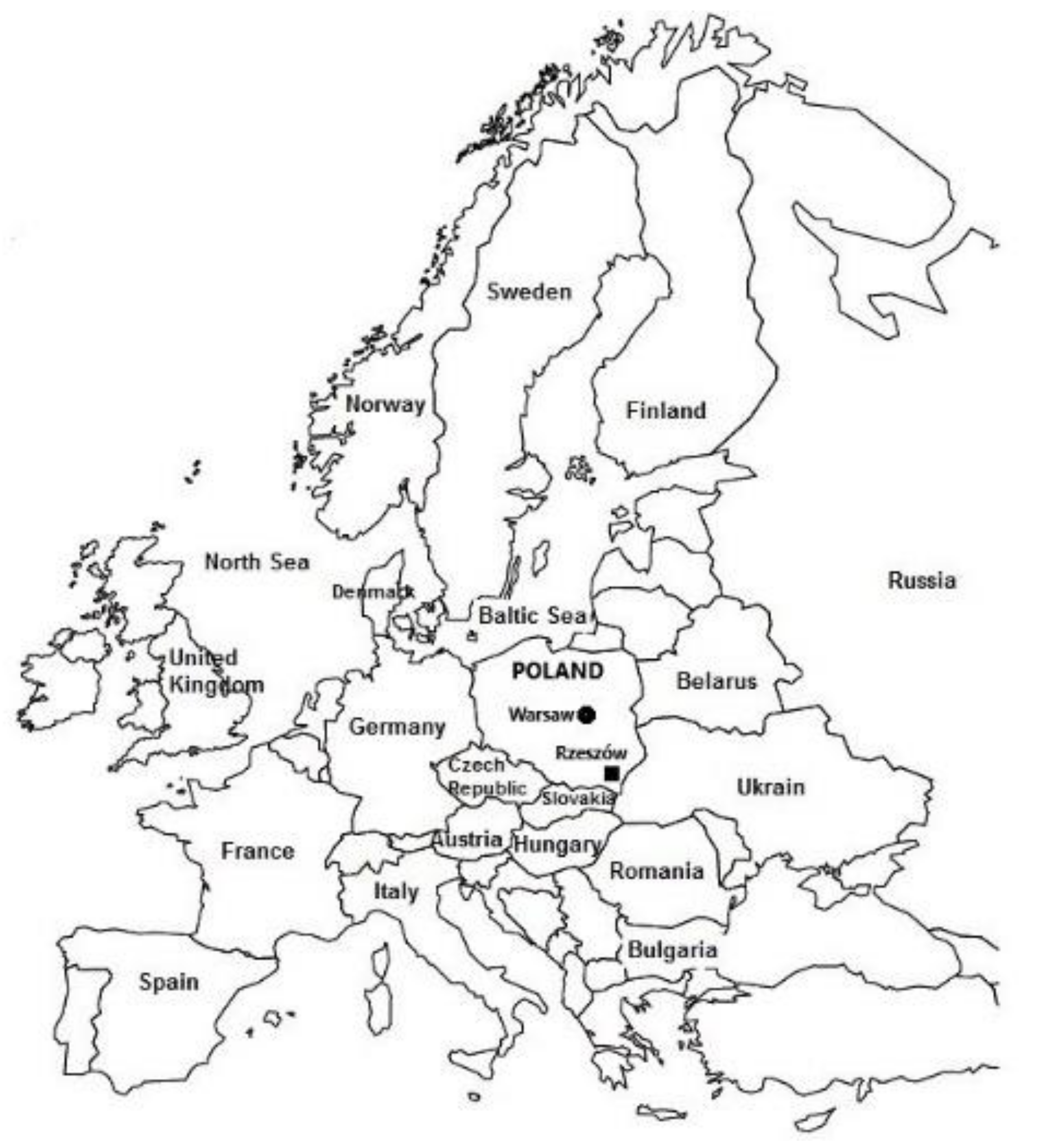
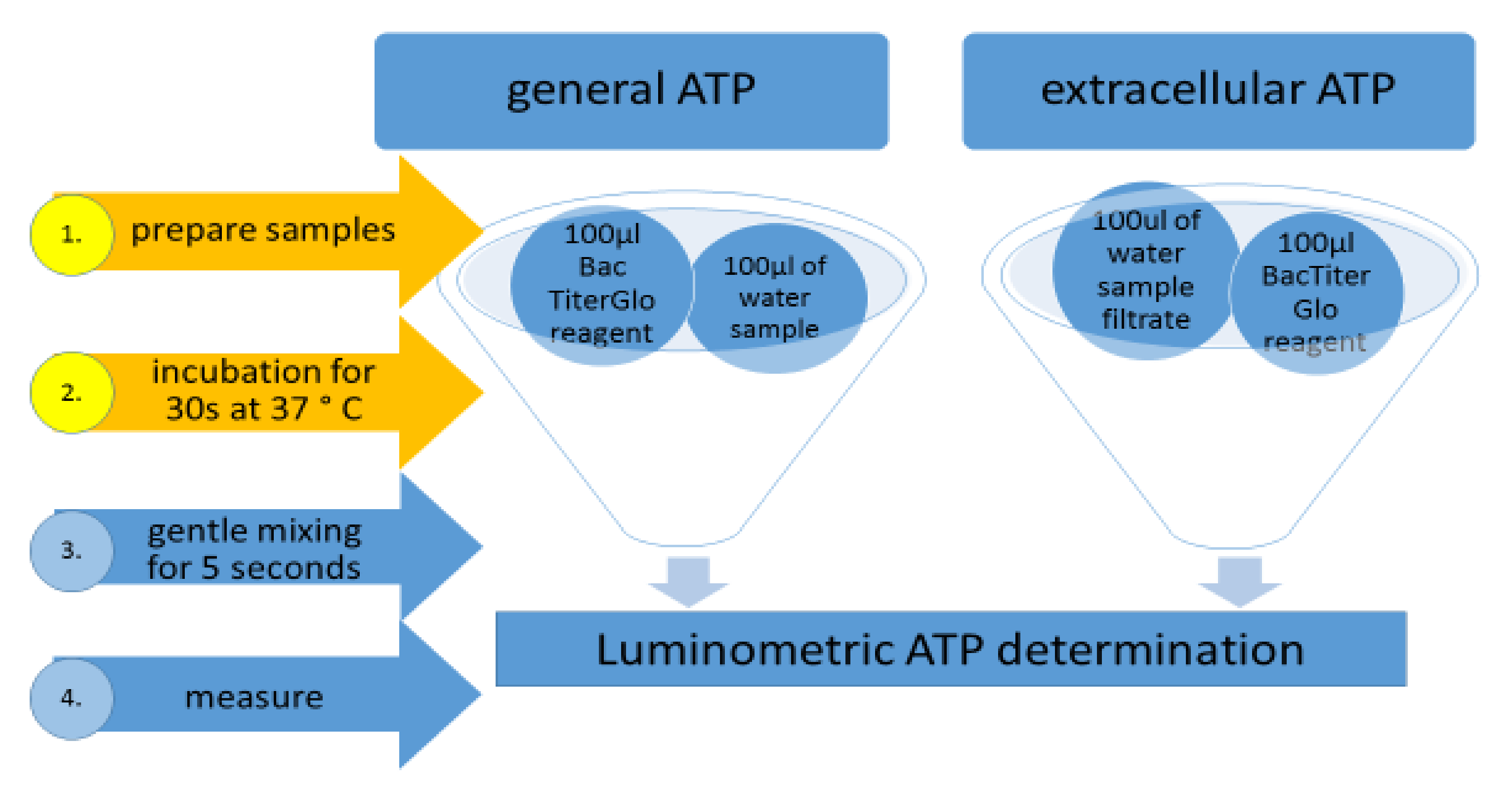
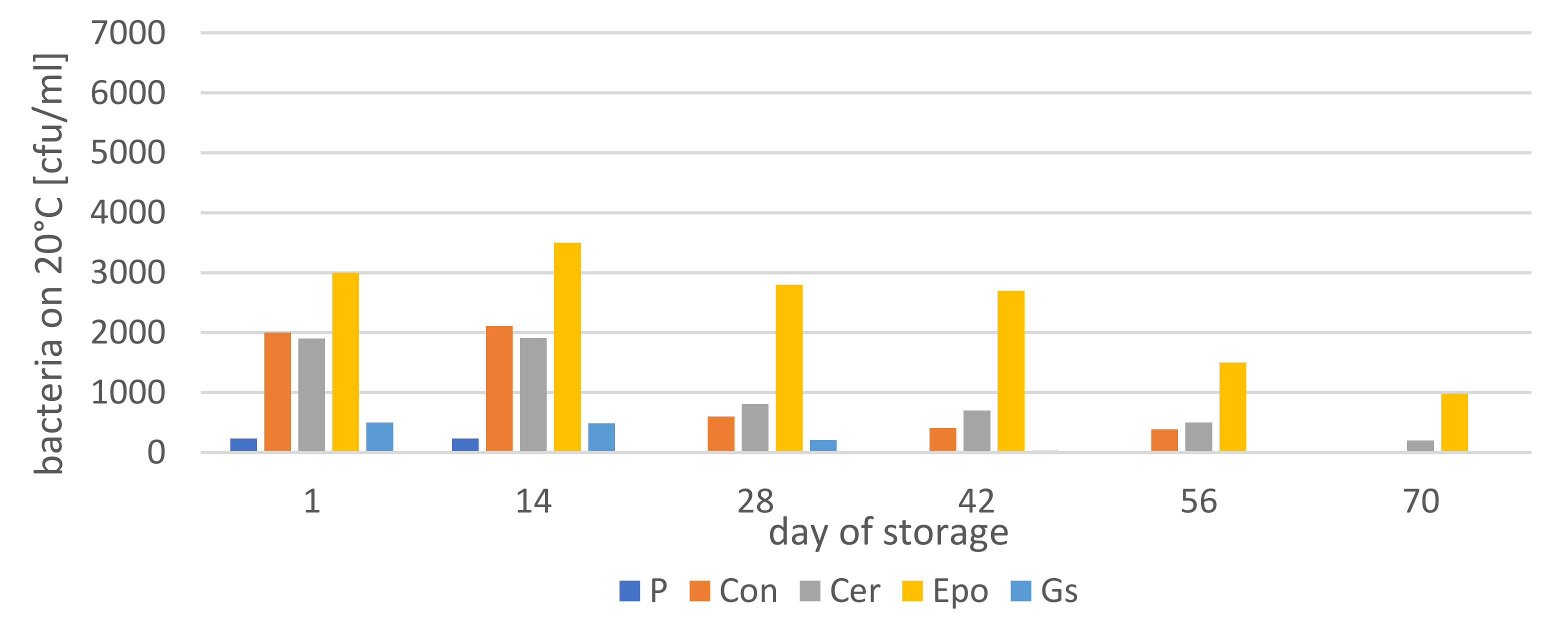
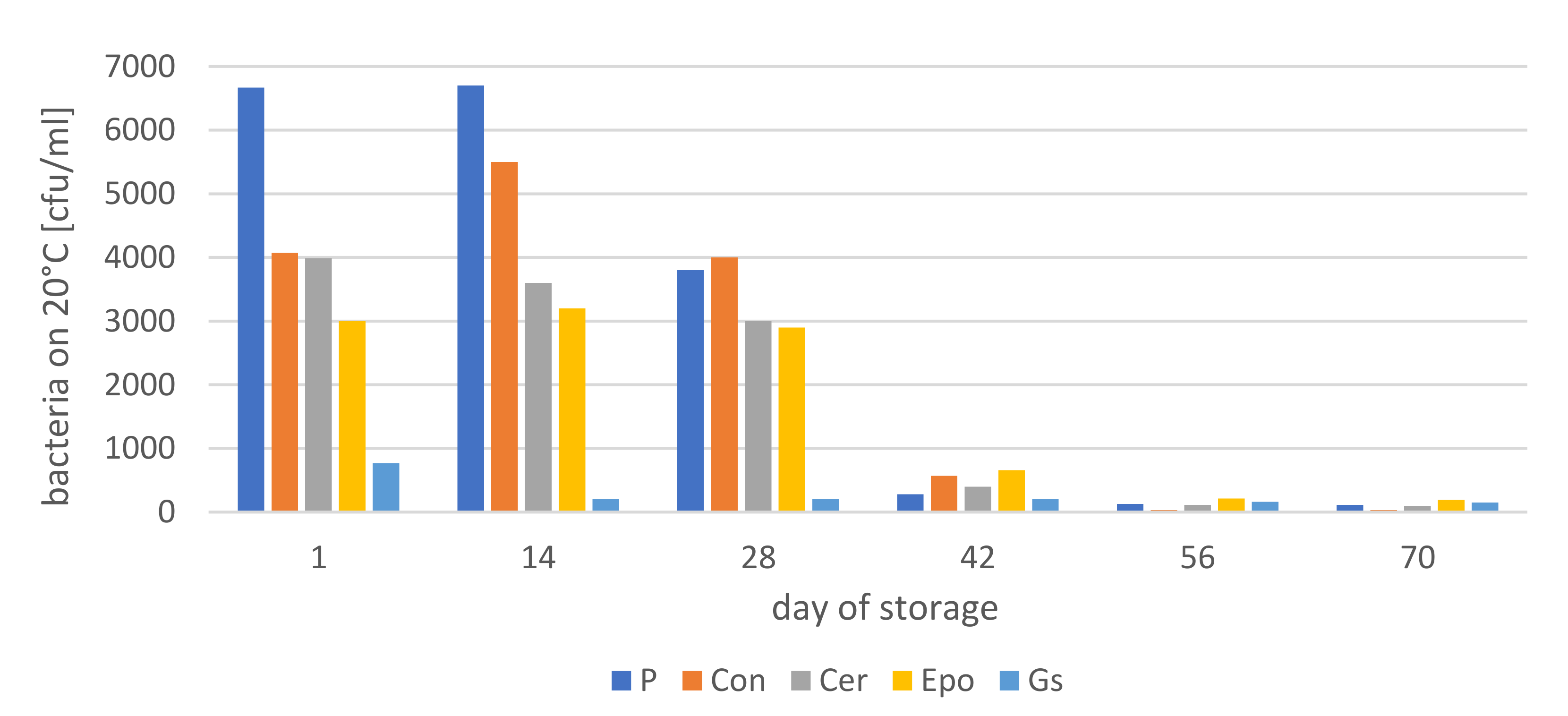


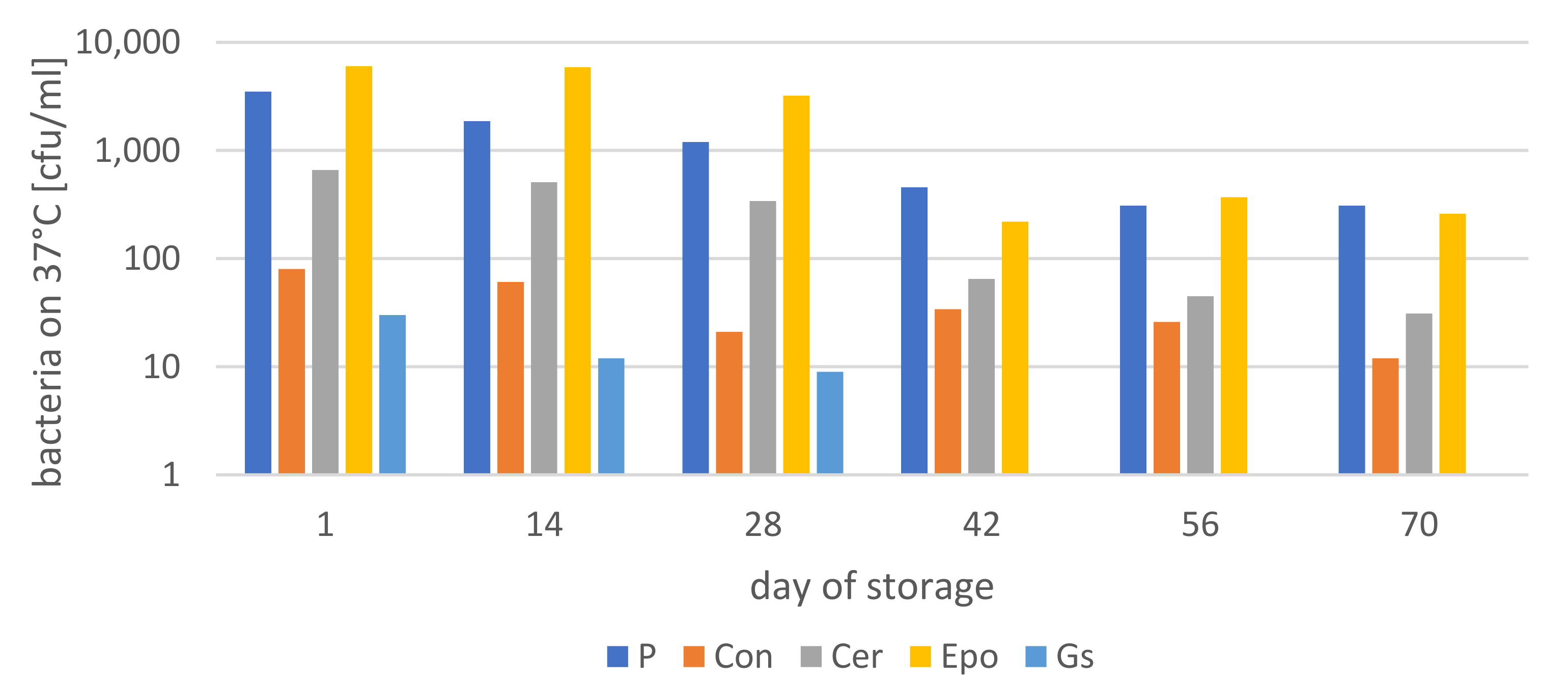
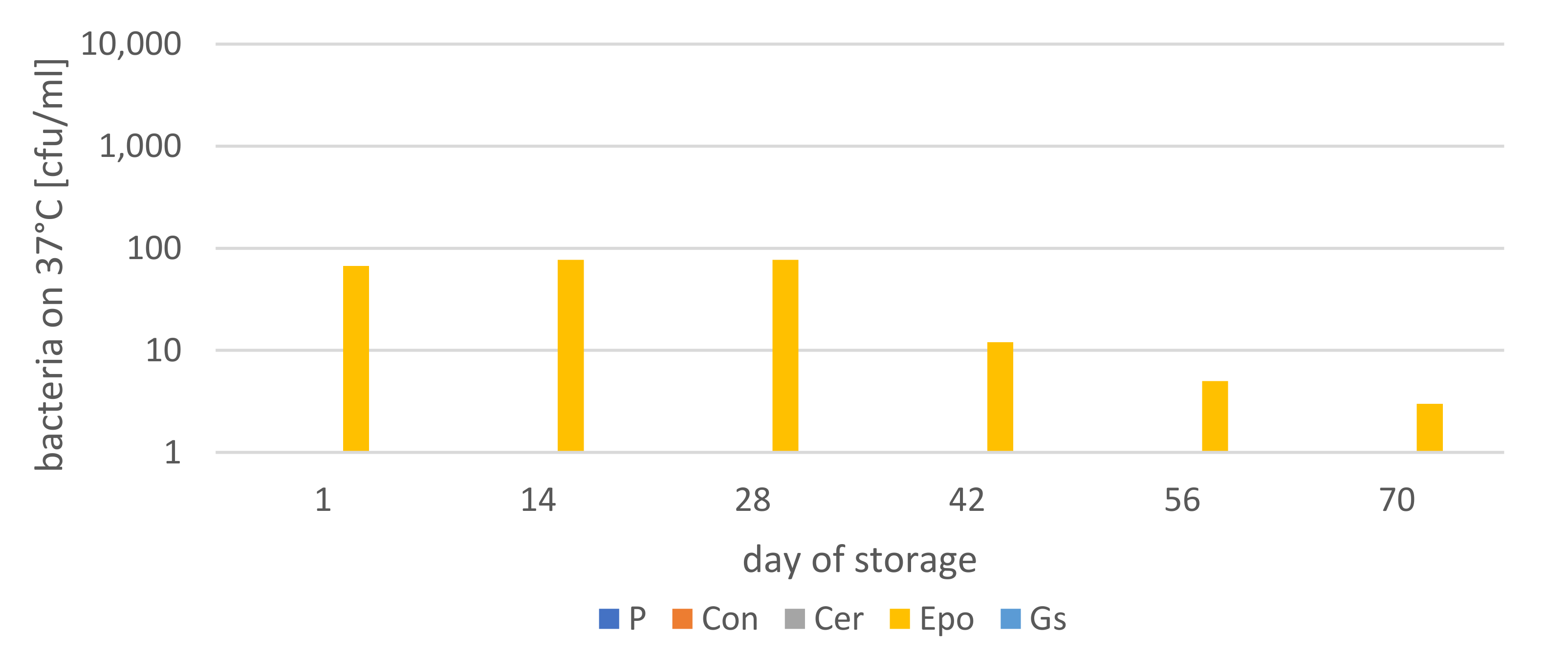
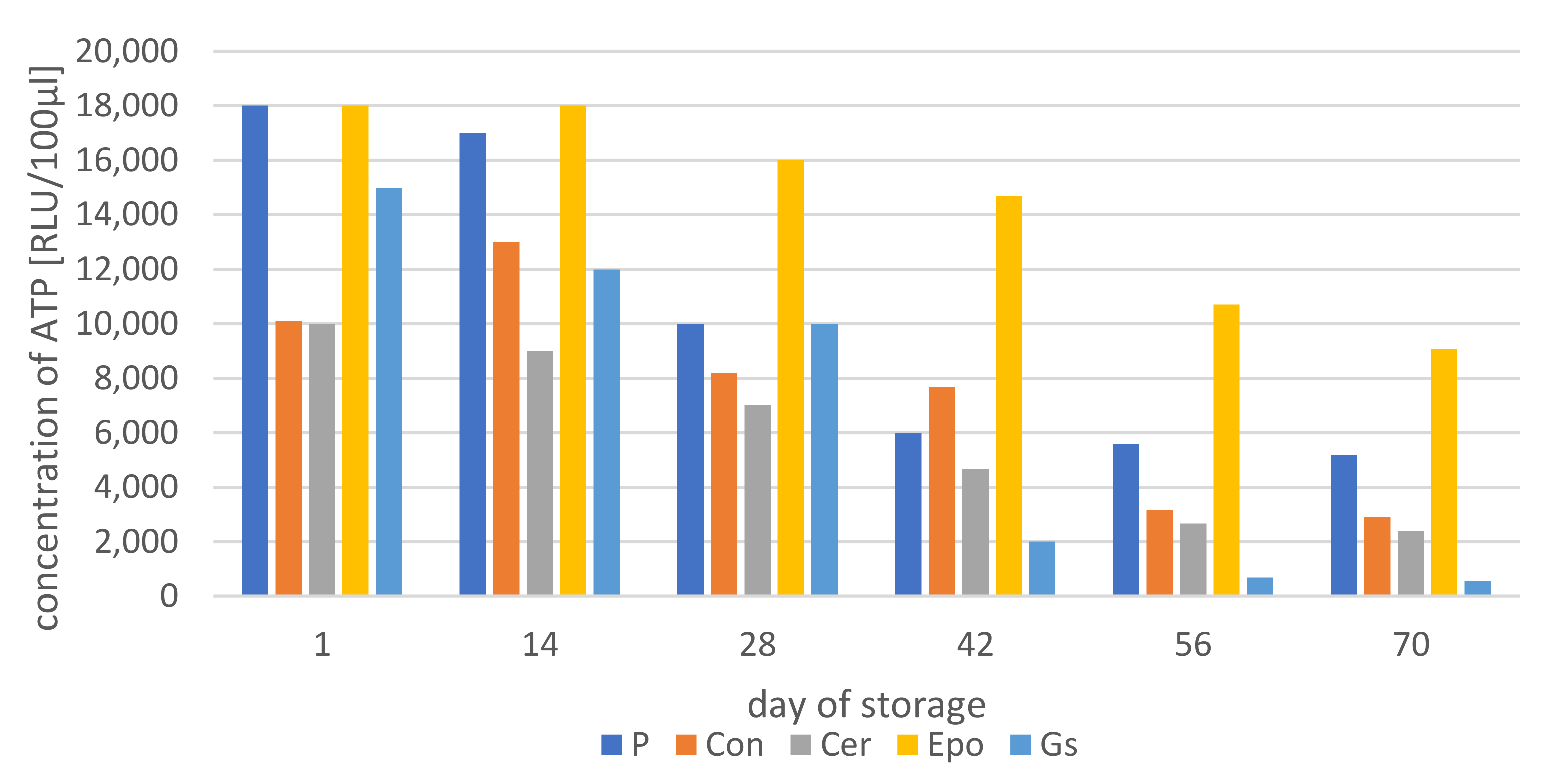
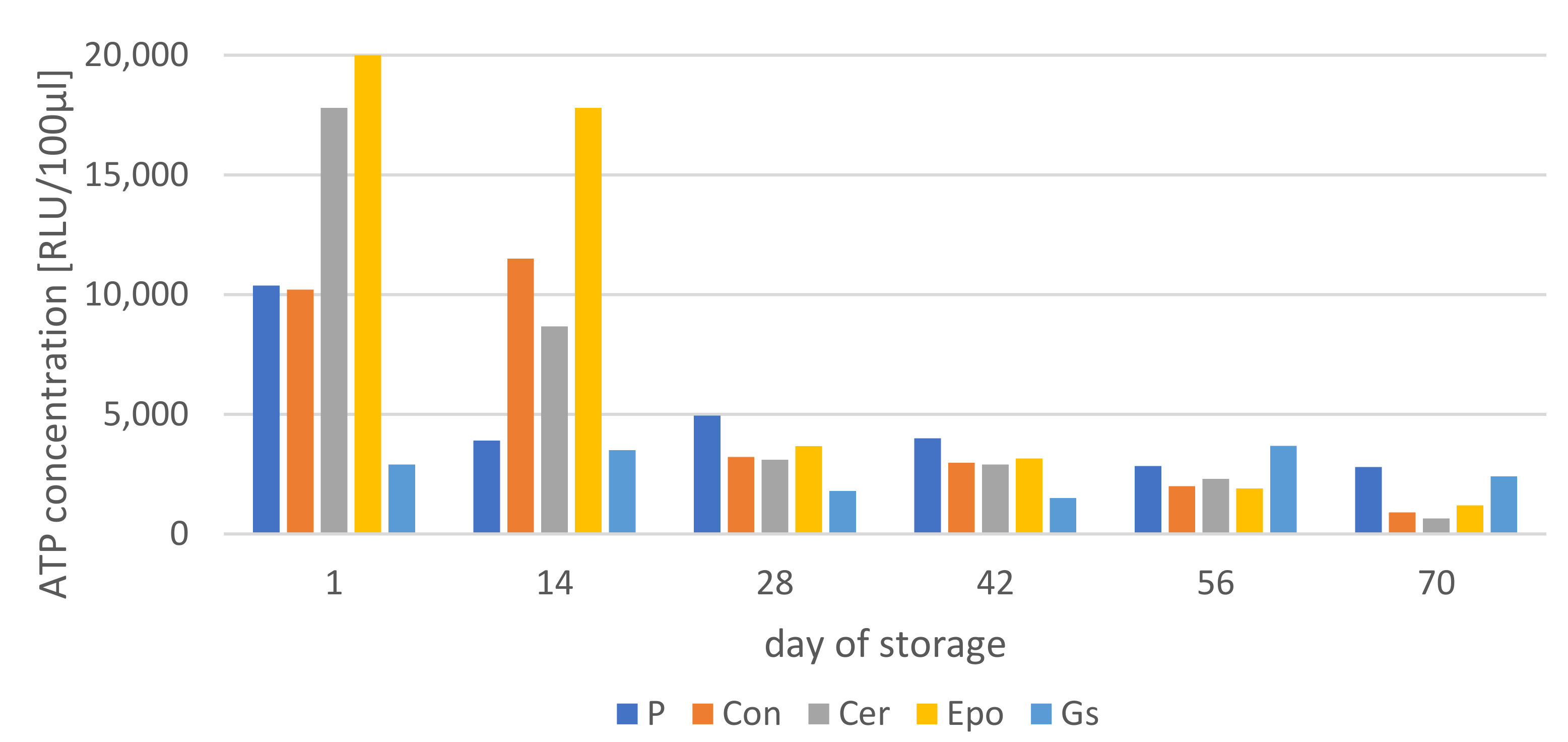

| Characteristic | Concrete Tile | Ceramic Tile | Epoxy Resin | Galvanized Steel Sheet |
|---|---|---|---|---|
| Location | 50°03′43.9″ N 22°06′53.6″ E | 50°03′45.2″ N 22°06′56.1″ E | 50°03′44.3″ N 22°06′53.5″ E | 50°03′51.5″ N 22°06′51.2″ E |
| Angle of inclination | 45° | 45° | 2° | 45° |
| Roof surface orientation | eastern | eastern | eastern | eastern |
| Components * | sand, Portland cement pigments—acrylic paint | clay, matte engage | Isocyanates, epoxy components, Pentamethyl piperidylsebacate, 3-isocyanatomethyl-3,5,5-trimethylcyclohexyl isocyanate, methyl 1,2,2,6,6-pentamethyl-4-piperidyl sebacate | iron, carbon, metals: chromium, nickel, manganese, tungsten, copper, molybdenum, titanium |
| Season | Parameter | |||||||
|---|---|---|---|---|---|---|---|---|
| pH ±0.05 | Turbidity NTU * ±0.01 | mg NNH4+/L ±0.005 | mg N-NO2−/L ±0.005 | mg N-NO3−/L ±0.005 | mg PO4−/L ±0.005 | mg TOC **/L ±0.001 | ||
| P | spring | 6.2 | 2.13 | 0.45 | 0.03 | 2.65 | 0.02 | 3.83 |
| summer | 6.2 | 1.21 | 0.30 | 0.07 | 1.48 | 0.02 | 2.58 | |
| autumn | 6.1 | 1.61 | 0.28 | 0.04 | 1.43 | 0.02 | 1.59 | |
| Con | spring | 6.5 | 4.15 | 0.29 | 0.06 | 1.30 | 0.02 | 2.13 |
| summer | 6.5 | 4.79 | 0.32 | 0.02 | 2.26 | 0.04 | 4.87 | |
| autumn | 7.4 | 3.21 | 0.31 | 0.07 | 2.43 | 0.02 | 2.91 | |
| Cer | spring | 6.0 | 5.72 | 0.28 | 0.05 | 3.12 | 0.02 | 3.51 |
| summer | 6.4 | 4.74 | 0.28 | 0.04 | 1.84 | 0.03 | 2.85 | |
| autumn | 7.1 | 1.97 | 0.21 | 0.03 | 1.46 | 0.02 | 3.32 | |
| Epo | spring | 6.3 | 6.11 | 0.20 | 0.05 | 3.43 | 0.03 | 6.17 |
| summer | 6.5 | 4.44 | 0.30 | 0.08 | 1.87 | 0.04 | 4.33 | |
| autumn | 6.8 | 4.27 | 0.30 | 0.05 | 2.56 | 0.02 | 4.25 | |
| Gs | spring | 6.1 | 3.17 | 0.47 | 0.04 | 2.22 | 0.01 | 1.89 |
| summer | 6.0 | 3.13 | 0.15 | 0.08 | 0.81 | 0.02 | 3.01 | |
| autumn | 5.8 | 1.12 | 0.09 | 0.07 | 1.13 | 0.02 | 2.61 | |
| Season | Parameter | |||||||
|---|---|---|---|---|---|---|---|---|
| pH ±0.05 | Turbidity NTU ±0.01 | mg NNH4+/L ±0.005 | mg N-NO2−/L ±0.005 | mg N-NO3−/L ±0.005 | mg PO4−/L ±0.005 | mg TOC/L ±0.001 | ||
| P | spring | 6.4 | 2.07↓ | 0.15↓ | 0.01↓ | 0.55↓ | 0.01↓ | 1.49↓ |
| summer | 6.2 | 1.05↓ | 0.11↓ | 0.04↓ | 0.58↓ | 0.01↓ | 1.65↓ | |
| autumn | 6.1 | 0.99↓ | 0.09↓ | 0.01↓ | 0.43↓ | 0.01↓ | 1.11↓ | |
| Con | spring | 6.9 | 3.15↓ | 0.29↓ | 0.02↓ | 0.60↓ | 0.01↓ | 1.90↓ |
| summer | 6.4 | 3.12↓ | 0.32↓ | 0.01↓ | 0.86↓ | 0.01↓ | 3.30↓ | |
| autumn | 7.3 | 2.28↓ | 0.31↓ | 0.03↓ | 0.83↓ | 0.01↓ | 2.50↓ | |
| Cer | spring | 6,4 | 2.50↓ | 0.29↓ | 0.02↓ | 0.60↓ | 0.01↓ | 1.90↓ |
| summer | 6.3 | 1.50↓ | 0.28↓ | 0.03↓ | 0.52↓ | 0.01↓ | 1.45↓ | |
| autumn | 7.2 | 1.40↓ | 0.28↓ | 0.01↓ | 0.94↓ | 0.01↓ | 2.10↓ | |
| Epo | spring | 6.4 | 4.70↓ | 0.21↓ | 0.02↓ | 0.76↓ | 0.01↓ | 1.91↓ |
| summer | 5.9 | 4.02↓ | 0.20↓ | 0.01↓ | 0.93↓ | 0.01↓ | 5.12↓ | |
| autumn | 6.6 | 3.10↓ | 0.30↓ | 0.04↓ | 0.97↓ | 0.01↓ | 3.30↓ | |
| Gs | spring | 6.2 | 1.15↓ | 0.47↓ | 0.01↓ | 0.29↓ | 0.01↓ | 1.70↓ |
| summer | 6.1 | 1.80↓ | 0.15↓ | 0.02↓ | 0.60↓ | 0.01↓ | 1.32↓ | |
| autumn | 6.2 | 1.03↓ | 0.09↓ | 0.02↓ | 0.08↓ | 0.01↓ | 2.15↓ | |
| Day of Storage | Spring | Summer | Autumn | ||||||||||||
|---|---|---|---|---|---|---|---|---|---|---|---|---|---|---|---|
| P | Con | Cer | Epo | Gs | P | Con | Cer | Epo | Gs | P | Con | Cer | Epo | Gs | |
| Number of Escherichia coli [cfu/100 mL] | |||||||||||||||
| 1 | 0 | 0 | 0 | 0 | 5 | 4 | 3 | 2 | 40 | 1 | 1 | 2 | 2 | 17 | 2 |
| 14 | 0 | 0 | 0 | 0 | 1 | 0 | 2 | 2 | 50 | 2 | 0 | 0 | 0 | 12 | 0 |
| 28 | 0 | 0 | 0 | 0 | 0 | 0 | 6 | 9 | 50 | 2 | 0 | 0 | 0 | 1 | 0 |
| 42 | 0 | 0 | 0 | 0 | 0 | 0 | 0 | 0 | 0 | 0 | 0 | 0 | 0 | 1 | 0 |
| 56 | 0 | 0 | 0 | 0 | 0 | 0 | 0 | 0 | 0 | 0 | 0 | 0 | 0 | 0 | 0 |
| 70 | 0 | 0 | 0 | 0 | 0 | 0 | 0 | 0 | 0 | 0 | 0 | 0 | 0 | 0 | 0 |
| Day of Storage | Spring | Summer | Autumn | ||||||||||||
|---|---|---|---|---|---|---|---|---|---|---|---|---|---|---|---|
| P | Con | Cer | Epo | Gs | P | Con | Cer | Epo | Gs | P | Con | Cer | Epo | Gs | |
| Number of Enterococci [cfu/100 mL] | |||||||||||||||
| 1 | 0 | 1 | 1 | 4 | 4 | 7 | 2 | 20 | 57 | 0 | 0 | 2 | 1 | 37 | 0 |
| 14 | 0 | 0 | 0 | 3 | 0 | 0 | 5 | 55 | 60 | 0 | 0 | 0 | 0 | 7 | 0 |
| 28 | 0 | 0 | 0 | 0 | 0 | 0 | 2 | 50 | 77 | 0 | 0 | 0 | 0 | 0 | 0 |
| 42 | 0 | 0 | 0 | 0 | 0 | 0 | 0 | 0 | 0 | 0 | 0 | 0 | 0 | 0 | 0 |
| 56 | 0 | 0 | 0 | 0 | 0 | 0 | 0 | 0 | 0 | 0 | 0 | 0 | 0 | 0 | 0 |
| 70 | 0 | 0 | 0 | 0 | 0 | 0 | 0 | 0 | 0 | 0 | 0 | 0 | 0 | 0 | 0 |
| Day of Storage | Spring | Summer | Autumn | ||||||||||||
|---|---|---|---|---|---|---|---|---|---|---|---|---|---|---|---|
| P | Con | Cer | Epo | Gs | P | Con | Cer | Epo | Gs | P | Con | Cer | Epo | Gs | |
| Number of Clostridium perfringens [cfu/100 mL] | |||||||||||||||
| 1 | 0 | 2 | 1 | 3 | 0 | 0 | 0 | 0 | 0 | 0 | 0 | 0 | 0 | 0 | 0 |
| 14 | 0 | 0 | 0 | 1 | 0 | 0 | 0 | 0 | 0 | 0 | 0 | 0 | 0 | 0 | 0 |
| 28 | 0 | 0 | 0 | 0 | 0 | 0 | 0 | 0 | 0 | 0 | 0 | 0 | 0 | 0 | 0 |
| 42 | 0 | 0 | 0 | 0 | 0 | 0 | 0 | 0 | 0 | 0 | 0 | 0 | 0 | 0 | 0 |
| 56 | 0 | 0 | 0 | 0 | 0 | 0 | 0 | 0 | 0 | 0 | 0 | 0 | 0 | 0 | 0 |
| Rainwater Collected From: | Spring | Summer | Autumn | |||
|---|---|---|---|---|---|---|
| Mesophilic | Psychrophilic | Mesophilic | Psychrophilic | Mesophilic | Psychrophilic | |
| precipitation (directly) | 0.827851 | 0.953434 | 0.918316 | 0.674004 | - | 0.627229 |
| roof covered with concrete tiles | 0.897749 | 0.873979 | 0.645955 | 0.384902 | - | 0.627229 |
| roof covered with ceramic tiles | 0.895669 | 0.945296 | 0.795021 | 0.665168 | - | 0.924684 |
| epoxy resin roof | 0.94229 | 0.883441 | 0.68997 | 0.410188 | −0.5902 | −0.22933 |
| roof covered with galvanized steel sheet | 0.916805 | 0.959076 | 0.19068 | 0.112606 | - | 0.827761 |
Publisher’s Note: MDPI stays neutral with regard to jurisdictional claims in published maps and institutional affiliations. |
© 2021 by the authors. Licensee MDPI, Basel, Switzerland. This article is an open access article distributed under the terms and conditions of the Creative Commons Attribution (CC BY) license (https://creativecommons.org/licenses/by/4.0/).
Share and Cite
Zdeb, M.; Zamorska, J.; Papciak, D.; Skwarczyńska-Wojsa, A. Investigation of Microbiological Quality Changes of Roof-Harvested Rainwater Stored in the Tanks. Resources 2021, 10, 103. https://doi.org/10.3390/resources10100103
Zdeb M, Zamorska J, Papciak D, Skwarczyńska-Wojsa A. Investigation of Microbiological Quality Changes of Roof-Harvested Rainwater Stored in the Tanks. Resources. 2021; 10(10):103. https://doi.org/10.3390/resources10100103
Chicago/Turabian StyleZdeb, Monika, Justyna Zamorska, Dorota Papciak, and Agata Skwarczyńska-Wojsa. 2021. "Investigation of Microbiological Quality Changes of Roof-Harvested Rainwater Stored in the Tanks" Resources 10, no. 10: 103. https://doi.org/10.3390/resources10100103
APA StyleZdeb, M., Zamorska, J., Papciak, D., & Skwarczyńska-Wojsa, A. (2021). Investigation of Microbiological Quality Changes of Roof-Harvested Rainwater Stored in the Tanks. Resources, 10(10), 103. https://doi.org/10.3390/resources10100103







